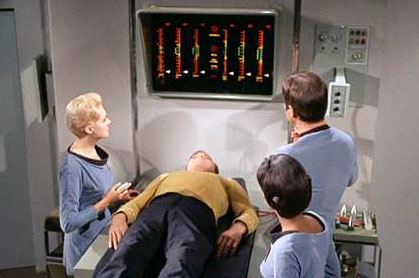This article is more than 1 year old
Cutting cancer rates: Data, models and a happy ending?
How surgery might be making cancer prognoses worse
The breast screening minefield
Our little team of researchers working on this problem suddenly found themselves with explanations for all kinds of anomalous results. For example, the breast cancer data showed that while the bimodal pattern exists for all women, the effect is twice as strong in pre-menopausal women compared to post-menopausal. Here was a possible explanation for the racial disparity in breast cancer outcomes.

Medical science: It's not as bad as Star Trek just yet
African-American women present with cancer at an average age of 46, while for European American women it’s 57. Surgical intervention in both groups would lead to relatively more African American women suffering from relapse simply because they are more likely to be pre-menopausal.
And similar thinking also lead our intrepid group of scientists into one of the most disputed and mendacious areas in medicine – breast screening. For those who think that medicine doesn’t suffer from the poisonous atmosphere that afflicts climate science, for example, think again.
The breast screening controversy is a minefield of disputed data, models and theories. Now the basic idea of screening is a simple one – catch the cancer early and you can intervene before it has spread and it’s too late to do anything. The core dispute revolves around the data.
Critics suggest that some women will be “over-diagnosed” – that is, they will have lumps that are not actually dangerous but, once detected will be treated as though they are invasive cancers. These “over-diagnosed” women will become cancer patients when really they should be no such thing. And both sides of the argument – both the entrenched “screeners” and the opposing “sceptics” – are arguing about the numbers. Will the number of women who benefit from screening exceed the women who will not?
Applying the model to the situation
Into this fray comes this new understanding of tumour dynamics and the bimodal pattern of relapse. It suggests that pre-menopausal women who are treated will have a greater rate of relapse than post-menopausal women. All of which suggests that the screening of 40-49 year old women will have a much lower overall benefit than the screening of 50+ year old women.
Unfortunately this was an unwelcome intervention as far as those entrenched “screeners” were concerned. They were campaigning (successfully, as it happens) for screening to be introduced for all women over the age of 40. Suddenly all research funding for this project dried up…
All was not lost, however
Now it just so happens that this is a story that has a potentially very happy ending. In 2010 a paper was published in an anaesthesiology journal by a group from Brussels. Patrice Forget and colleagues looked at the data for 327 consecutive mastectomy patients to see if there was a relationship between relapse and the pain-killing drugs used during surgery.
It has to be said that this is a pretty unusual thing to do. Mostly anaesthesiologists have a very focused attention span – their job is to keep the patient alive and pain-free during and immediately after surgery. Thankfully this enterprising group took a longer view and came up with a surprising result. Patients treated with the non-steroidal anti-inflammatory drug ketorolac (a cousin of diclofenac, which is an over-the-counter drug in most countries) had significantly fewer instances of relapse compared to other drugs, particularly opiate-based pain killers.
Was this a statistical fluke? Well, it looks like the effect is real. And it may extend to other cancer types, not just breast cancer. This is where we get our happy ending – potentially. It means that a simple change in procedure, switching to an existing and cheap drug like ketorolac, can make a huge impact on the risk of subsequent relapse and death. It almost abolishes that bimodal relapse pattern.
At a stroke the cut of a cancer surgeon’s knife becomes curative again, with the threat of rapid metastatic spread disappearing. If a new drug appeared on the market with that much potential we’d be marching in the streets demanding access to it for our loved ones with cancer.
What stands in the way? The effect needs to be confirmed in a clinical trial. Statistics are one thing, but actually having a randomised controlled trial is still the gold standard in medicine. Thankfully such a trial is going on at the moment. A Belgian charity, the Anticancer Fund, is working with Patrice Forget and colleagues on a trial with breast cancer patients.
If confirmed, then this is a story with a happy ending that saves thousands of lives across the world. ®
